Assessing the Dynamics of Land Use/Land Cover Changes between 1974 and 2016: A Study Case of the Bustillos Basin Using Remote Sensing
Abstract
:1. Introduction
2. Materials and Methods
2.1. Study Area
2.2. Data Sources
2.3. Image Processing
2.4. Classification Accuracy
2.5. Change Analysis
3. Results
3.1. False-Color Images
3.2. Land Use Classification
3.3. Land Use Changes
3.4. Gains, Losses, and Exchanges of the Categories
4. Discussion
4.1. False-Color Composites and Classes Delimitation
4.2. Land Use Changes and Implications
5. Conclusions
Author Contributions
Funding
Data Availability Statement
Acknowledgments
Conflicts of Interest
References
- Perring, M.P.; De Frenne, P.; Baeten, L.; Maes, S.L.; Depauw, L.; Blondeel, H.; Carón, M.M.; Verheyen, K. Global environmental change effects on ecosystems: The importance of land-use legacies. Glob. Change. Biol. 2016, 22, 1361–1371. [Google Scholar] [CrossRef]
- Fifth National Climate Assessment, Changes in Climate and Land Use Affect Land-System Resilience. Available online: https://nca2023.globalchange.gov/chapter/6/ (accessed on 17 June 2024).
- Borrelli, P.; Robinson, D.A.; Panagos, P.; Lugato, E.; Yang, J.E.; Alewell, C.; Wuepper, D.; Montanarella, L.; Ballabio, C. Land use and climate change impacts on global soil erosion by water (2015–2070). Proc. Natl. Acad. Sci. USA 2020, 117, 21994–22001. [Google Scholar] [CrossRef]
- Pool, D.B.; Panjabi, A.O.; Macias-Duarte, A.; Solhjem, D.M. Rapid expansion of croplands in Chihuahua, Mexico threatens declining North American grassland bird species. Biol. Conserv. 2014, 170, 274–281. [Google Scholar] [CrossRef]
- Schiavina, M.; Melchiorri, M.; Corbane, C.; Florczyk, A.J.; Freire, S.; Pesaresi, M.; Kemper, T. Multi-scale estimation of land use efficiency (SDG 11.3. 1) across 25 years using global open and free data. Sustainability 2019, 11, 5674. [Google Scholar] [CrossRef]
- Díaz Caravantes, R.; Bravo Peña, L.C.; Alatorre Cejudo, L.C.; Sánchez Flores, E. Geospatial Analysis of the Interaction between Land and Water Use in the Peri-Urban Area of Cuauhtémoc, Chihuahua: A Socio-Environmental Study in Northern Mexico. Investig. Geogr. Boletín 2014, 83, 117–131. [Google Scholar] [CrossRef]
- Hasan, S.S.; Zhen, L.; Miah, M.G.; Ahamed, T.; Samie, A. Impact of land use change on ecosystem services: A review. Environ. Dev. 2020, 34, 100527. [Google Scholar] [CrossRef]
- United Nations. Transforming Our World: The 2030 Agenda for Sustainable Development; The Strategic Plan 2020–2023; United Nations, Department of Economic and Social Affairs Habitat, U.N.: New York, NY, USA, 2019. [Google Scholar]
- United Nations (UN)-Hábitat. La Dimensión Urbana de los Objetivos de Desarrollo Sostenible. Available online: https://onuhabitat.org.mx/ (accessed on 15 October 2023).
- Maja, M.M.; Ayano, S.F. The impact of population growth on natural resources and farmers’ capacity to adapt to climate change in low-income countries. Earth Syst. Environ. 2021, 5, 271–283. [Google Scholar] [CrossRef]
- Foley, J.A.; Defries, R.; Asner, G.P. Global Consequences of Land Use. Science 2005, 309, 570–574. [Google Scholar] [CrossRef]
- Clarity and Leadership for Environmental Awareness and Research (CLEAR Center). Cattle and Land Use: The Differences between Arable Land and Marginal Land and How Cattle Use Each. Available online: https://clear.ucdavis.edu/explainers/cattle-and-land-use-differences-between-arable-land-and-marginal-land-and-how-cattle-use (accessed on 18 February 2024).
- Viana, C.M.; Freire, D.; Abrantes, P.; Rocha, J.; Pereira, P. Agricultural land systems importance for supporting food security and sustainable development goals: A systematic review. Sci. Total Environ. 2022, 806, 150718. [Google Scholar] [CrossRef]
- Foley, J.; Ramankutty, N.; Brauman, K.; Cassidy, E.S.; Gerber, J.S.; Johnston, M.; Mueller, N.D.; O’Connell, C.; Ray, D.K.; West, P.C.; et al. Solutions for a Cultivated Planet. Nature 2011, 478, 337–342. [Google Scholar] [CrossRef]
- McGarigal, K.; Tagil, S.; Cushman, S.A. Surface metrics: An alternative to patch metrics for the quantification of landscape structure. Landsc. Ecol. 2009, 24, 433–450. [Google Scholar]
- Secretaría de Medio Ambiente y Recursos Naturales (SEMARNAT). Información Adicional al Trámite SEMARNAT-02-001 Solicitud de Autorización de Cambio de Uso de Suelo en Terrenos Forestales. Gobierno de México. Available online: https://www.gob.mx/semarnat/documentos/tramite-semarnat-02-001 (accessed on 15 February 2021).
- López-Vazquez, V.H.; Balderas, P.M.; Chávez, M.C.; Perez, J.J.; Gutiérrez, C.G. Cambio de uso de suelo e implicaciones socioeconómicas en un área mazahua del altiplano mexicano. CIENCIA Ergo-Sum 2015, 22, 136–144. [Google Scholar]
- INEGI (Instituto Nacional de Estadística Geografía e Informática). Subsistema de Información Demográfica y Social. Censos y Conteos de Población y Vivienda. 2024. Available online: https://www.inegi.org.mx/programas/ccpv/1970/#publicaciones (accessed on 20 July 2024).
- SADER (Secretaría de Agricultura y Desarrollo Rural). Servicio de Información Agroalimentaria y Pesquera (SIAP), Datos Abiertos. Chihuahua, México. 2024. Available online: http://infosiap.siap.gob.mx/gobmx/datosAbiertos.php (accessed on 20 July 2024).
- INEGI (Instituto Nacional de Estadística Geografía e Informática). V Censo Agrícola Ganadero y Ejidal 1970. Dirección General de Estadística. México. 1975. Available online: https://www.inegi.org.mx/contenidos/productos/prod_serv/contenidos/espanol/bvinegi/productos/historicos/1329/702825111144/702825111144_1.pdf (accessed on 19 July 2024).
- INEGI (Instituto Nacional de Estadística Geografía e Informática). Dirección General de Difusión. In Cuaderno Estadístico Municipal Cuauhtémoc Chihuahua 2001; INEGI (Instituto Nacional de Estadística Geografía e Informática): Chihuahua, Mexico, 2002; 174p. [Google Scholar]
- Conociendo la Laguna de Bustillos. Available online: https://storymaps.arcgis.com/stories/45b00034bc9942bcbe5e9ee6c4bd6b3d (accessed on 17 June 2024).
- Comisión Nacional Para el Conocimiento y Uso de la Biodiversidad (CONABIO). 37 Lago Bustillos. Available online: http://www.conabio.gob.mx/conocimiento/regionalizacion/doctos/rhp_037.html (accessed on 18 July 2024).
- A la Torre, L.C.; García, A.K.; Rodríguez, A.J.; Erives, V.; González, E. Estimación de la erosión potencial de la cuenca laguna de Bustillos, Chihuahua, Mexico. Dialnet 2014, 249–258. [Google Scholar]
- Zhu, L.; Suomalainen, J.; Liu, J.; Hyyppä, J.; Kaartinen, H.; Haggren, H. A review: Remote sensing sensors. Multi-Purp. Appl. Geospat. Data 2018, 19. [Google Scholar] [CrossRef]
- Vázquez-Quintero, G.; Solís-Moreno, R.; Pompa-García, M.; Villarreal-Guerrero, F.; Pinedo-Alvarez, C.; Pinedo-Alvarez, A. Detection and projection of forest changes by using the Markov Chain Model and Cellular Automata. Sustainability 2016, 8, 236. [Google Scholar] [CrossRef]
- Flores, S.E.; Yool, S.R. Sensitivity of change vector analysis to land cover change in an arid ecosystem. Int. J. Remote Sens. 2007, 28, 1069–1088. [Google Scholar] [CrossRef]
- Verburg, P.H.; Crossman, N.; Ellis, E.C. Land system science and sustainable development of the earth system: A global land project perspective. Anthropocene 2015, 3, 29–41. [Google Scholar] [CrossRef]
- Al-sharif, A.A.; Pradhan, B. Monitoring and Predicting Land Use Change in Tripoli Metropolitan City Using an Integrated Markov Chain and Cellular Automata Models in GIS. Arab. J. Geosci. 2014, 7, 4291–4301. [Google Scholar] [CrossRef]
- Talukdar, S.; Singha, P.; Mahato, S.; Pal, S.; Liou, Y.A.; Rahman, A. Land-use land-cover classification by machine learning classifiers for satellite observations—A review. Remote Sens. 2020, 12, 1135. [Google Scholar] [CrossRef]
- Phan, T.N.; Kuch, V.; Lehnert, L.W. Land cover classification using Google Earth Engine and random forest classifier—The role of image composition. Remote Sens. 2020, 12, 2411. [Google Scholar] [CrossRef]
- MohanRajan, S.N.; Loganathan, A.; Manoharan, P. Survey on Land Use/Land Cover (LU/LC) change analysis in remote sensing and GIS environment: Techniques and Challenges. Environ. Sci. Pollut. R. 2020, 27, 29900–29926. [Google Scholar] [CrossRef]
- Nasa Earth Observatory. Available online: https://earthobservatory.nasa.gov/features/FalseColor (accessed on 16 June 2024).
- Pinedo, A.C.; Pinedo, A.A.; Martinez, Q.R.M. Análisis de áreas deforestadas en la región centro-norte de la Sierra Madre Occidental, Chihuahua, México. Tecnociencia Chihuah. 2007, 1, 36–43. [Google Scholar] [CrossRef]
- Segura, F.; Tricando, M.M. Evolución del paisaje y estado de conservación de la reserva forestal de Valdivia. Land 2003, 19, 197–209. [Google Scholar]
- Rimal, B.; Zhang, L.; Keshtkar, H.; Haack, B.; Rijal, S.; Zhang, P. Land use/land cover dynamics and modeling of urban land expansion by the integration of cellular automata and markov chain. ISPRS Int. J. Geo-Inf. 2018, 7, 154. [Google Scholar] [CrossRef]
- Food and Agriculture Organization of the United Nations (FAO). Base Referencial Mundial del Recurso Suelo. In Informes Sobre Recursos Mundiales del Suelo; FAO: Rome, Italy, 2015; Volume 106. [Google Scholar]
- Comisión Nacional del Agua (CONAGUA). Registro Público de Derechos de Agua. Available online: https://www.gob.mx/conagua (accessed on 15 October 2023).
- Instituto Nacional de Estadística y Geografía (INEGI). Censo General de Población y Vivienda, Instituto Nacional de Estadística, Geografía e Informática, México. Available online: https://www.inegi.org.mx (accessed on 15 October 2023).
- Comisión Nacional para el Conocimiento y Uso de la Biodiversidad (CONABIO). La Biodiversidad en Chihuahua: Estudio de Estado. 2014. Available online: https://www.biodiversidad.gob.mx/region/EEB/estudios/ee_chihuahua (accessed on 15 October 2023).
- Markham, B.L.; Arvidson, T.; Barsi, J.A.; Choate, M.; Kaita, E.; Levy, R.; Lubke, M.; Masek, J.G. Comprehensive Remote Sensing; Elsevier: Amsterdam, The Netherlands, 2018; pp. 27–90. [Google Scholar] [CrossRef]
- Gonzalez, L.; Yamamoto, H. The wall: The Earth in true natural color from real-time geostationary satellite imagery. Remote Sens. 2020, 12, 2375. [Google Scholar] [CrossRef]
- Jiang, H.; Eastman, J.R. Application of Fuzzy Measures in Multi-Criteria Evaluation in GIS. Int. J. Geogr. Inf. Sci. 2000, 14, 173–184. [Google Scholar] [CrossRef]
- Awotwi, A.; Anornu, G.K.; Quaye-Ballard, J.A.; Annor, T. Monitoring Land Use and Land Cover Changes Due to Extensive Gold Mining, Urban Expansion, and Agriculture in the Pra River Basin of Ghana, 1986–2025. Land Degrad. Dev. 2018, 29, 3331–3343. [Google Scholar] [CrossRef]
- Yang, C.; Wu, G.; Ding, K.; Shi, T.; Li, Q.; Wang, J. Improving land use/land cover classification by integrating pixel unmixing and decision tree methods. Remote Sens. 2017, 9, 1222. [Google Scholar] [CrossRef]
- Kafy, A.A.; Shuvo, R.M.; Naim, M.N.H.; Sikdar, M.S.; Chowdhury, R.R.; Islam, M.A.; Sarker, H.S.; Khan, H.H.; Kona, M.A. Remote sensing approach to simulate the land use/land cover and seasonal land surface temperature change using machine learning algorithms in a fastest-growing megacity of Bangladesh. Remote Sens. Appl. Soc. Environ. 2021, 21, 100463. [Google Scholar] [CrossRef]
- Valero Medina, J.A.; Alzate Atehortúa, B.E. Comparison of maximum likelihood, support vector machines, and random forest techniques in satellite images classification. Rev. Tecnura 2019, 23, 13–26. [Google Scholar] [CrossRef]
- Pineda-López, R.; Febvre, N.; Martínez, M. Importancia de proteger pequeñas áreas periurbanas por su riqueza avifaunística: El caso de Mompaní, Querétaro, México. Huitzil, Revista Mex. Ornitol. 2010, 11, 69–80. [Google Scholar]
- How Maximum Likelihood Classification Works. Esri. Available online: https://desktop.arcgis.com/en/arcmap/latest/tools/spatial-analyst-toolbox/how-maximum-likelihood-classification-works.htm (accessed on 26 May 2024).
- Smits, P.C.; Dellepiane, S.G.; Schowengerdt, R.A. Quality assessment of image classification algorithms for land-cover mapping: A review and a proposal for a cost-based approach. Int. J. Remote Sens. 1999, 20, 1461–1486. [Google Scholar]
- Congalton, R.G.; Oderwald, R.G.; Mead, R.A. Assessing Landsat classification accuracy using discrete multivariate analysis statistical techniques. Photogramm. Eng. Remote Sens. 1983, 49, 1671–1678. [Google Scholar]
- Pontius, R.G., Jr.; Shusas, E.; McEachern, M. Detecting important categorical land changes while accounting for persistence. Agric. Ecosyst. Environ. 2004, 101, 251–268. [Google Scholar] [CrossRef]
- Pontius, R.G., Jr.; Cheuk, M.L. A generalized cross-tabulation matrix to compare soft-classified maps at multiple resolutions. Int. J. Geogr. Inf. Sci. 2006, 20, 1–30. [Google Scholar] [CrossRef]
- Ibarra-Bonilla, J.S.; Villarreal-Guerrero, F.; Prieto-Amparán, J.A.; Santellano-Estrada, E.; Pinedo-Alvarez, A. Characterizing the impact of Land-Use/Land-Cover changes on a Temperate Forest using the Markov model. Egypt. J. Remote Sens. Space Sci. 2021, 24, 1013–1022. [Google Scholar] [CrossRef]
- Ali, K.; Johnson, B.A. Land-use and land-cover classification in semi-arid areas from medium-resolution remote-sensing imagery: A deep learning approach. Sensors 2022, 22, 8750. [Google Scholar] [CrossRef]
- Lasanta, T.; Vicente-Serrano, S.M. Complex land cover change processes in semiarid Mediterranean regions: An approach using Landsat images in northeast Spain. Remote Sens. Environ. 2012, 124, 1–14. [Google Scholar] [CrossRef]
- Wang, J.; Bretz, M.; Dewan, M.A.A.; Delavar, M.A. Machine learning in modelling land-use and land cover-change (LULCC): Current status, challenges and prospects. Sci. Total Environ. 2022, 822, 153559. [Google Scholar] [CrossRef]
- Briceño-Hidalgo, Y.I. Análisis Espacio Temporal del Cambio de Uso de Suelo en Bosques Templados de la Sierra Tarahumara, Chihuahua. Bachelor’s Thesis, Autonomous University of Chihuahua (UACh), Chihuahua, Mexico, 2020. [Google Scholar]
- Hilker, T.M.; Wulder, N.; Coops, J.; Linke, G.; McDermid, J.; Masek, F.; Gaoy, J.C. A new data fusion model for high spatial- and temporal-resolution mapping of forest disturbance based on Landsat and MODIS. Remote Sens. Env. 2009, 113, 1613–1627. [Google Scholar] [CrossRef]
- Healey, S.P.; Cohen, W.B.; Zhiqiang, Y.; Krankina, O.N. Comparison of Tasseled Cap-based Landsat data structures for use in forest disturbance detection. Remote Sens. Env. 2005, 101, 301–310. [Google Scholar] [CrossRef]
- Lemenkova, P. Robust vegetation detection using RGB colour composites and isoclust classification of the Landsat TM image. Geomat. Landmanag. Land. 2021, 147–167. [Google Scholar]
- Antillon, M.Y.; Corral, G.M.; A la Torre, L.C. Análisis de los Cambios de Cobertura y Uso de Suelo en los Márgenes de la Laguna de Bustillos Chihuahua: Efectos de la Expansión Agrícola. Available online: https://www.uacj.mx/CGTI/CDTE/JPM/Documents/SELPER/assets/m005.pdf (accessed on 7 July 2024).
- Manjarrez-Domínguez, C.; Pinedo-Alvarez, A.; Pinedo-Alvarez, C.; Villarreal-Guerrero, F.; Cortes-Palacios, L. Cortes-Palacios, L. Vegetation Landscape Analysis due to Land Use Changes on Arid Lands. Pol. J. Ecol. 2015, 63, 272–279. [Google Scholar] [CrossRef]
- García Nieto, H.; García Daguer, R.R.; Moreno Sánchez, R.; González Ramos, A. Using Remote Sensors and GIS to Delimit Changes in Agricultural Land Use from 1970 to 1997 in the State of Guanajuato. Invest. Geog 2002, 47, 92–112. [Google Scholar]
- A la Torre, L.C.; Granados, A.; Bravo, L.C.; Torres, M.E.; Wiebe, L.C.; Uc, M.I.; González, M.O.; Sánchez, E.; Rojas, H.L.; Salas, V. Ineficiencia de riego rodado agrícola en la cuenca de la laguna de Bustillos, Chihuahua, México: Características geométricas de las parcelas agrícolas y abatimiento del acuífero. Tecnol. Cienc. Agua 2019, 10, 241–281. [Google Scholar] [CrossRef]
- Prieto-Amparán, J.A.; Pinedo-Alvarez, A.; Villarreal-Guerrero, F.; Pinedo-Alvarez, C.; Morales-Nieto, C.; Manjarrez-Domínguez, C. Past and future spatial growth dynamics of Chihuahua city, Mexico: Pressures for land use. ISPRS Int. J. Geo-Inf. 2016, 5, 235. [Google Scholar] [CrossRef]
- Amado-Álvarez, J.P.; Pérez-Cutillas, P.; Ramirez-Valle, O.; Alarcón-Cabañero, J.J. Análisis de la calidad del agua en las lagunas de Bustillos y de los mexicanos (Chihuahua, México). Papeles De Geogr. 2016, 62, 107–118. [Google Scholar] [CrossRef]
- Rawat, J.S.; Kumar, M. Monitoring Land Use/Cover Change Using Remote Sensing and GIS Techniques: A Case Study of Hawalbagh Block, District Almora, Uttarakhand, India. Egypt. J. Remote Sens. Space Sci. 2015, 18, 77–84. [Google Scholar] [CrossRef]
- Sadiq Khan, M.; Ullah, S.; Sun, T.; Rehman, A.U.; Chen, L. Land-use/land-cover changes and its contribution to urban heat Island: A case study of Islamabad, Pakistan. Sustainability 2020, 12, 3861. [Google Scholar] [CrossRef]
- Martínez-Sifuentes, A.R.; Villanueva-Díaz, J.; Estrada-Ávalos, J.; Vázquez-Vázquez, C.; Orona-Castillo, I. Soil loss and runoff modification caused by land use change in the Conchos River basin, Chihuahua. Nova Sci. 2020, 12. [Google Scholar] [CrossRef]
- Ducks Unlimited of Mexico (DUMAC). The Current State of the Bustillos Lagoon behind the Ecological Disaster. Available online: https://dumac.org/2024/07/25/la-laguna-de-bustillos-detras-del-desastre-ecologico/ (accessed on 30 July 2024).
- De la Maza-Benignos, M.; Banda-Villanueva, I.; Mendoza-González, G.; Leal-Nares, O.A.; Rendón-Herrera, G. Reporte del estado de los pastizales del Desierto Chihuahuense. Pronatura Noreste-Am. Bird Conserv. 2019. [Google Scholar]
- Rafiei-Sardooi, E.; Azareh, A.; Shooshtari, S.J.; Parteli, E.J. Long-term assessment of land-use and climate change on water scarcity in an arid basin in Iran. Ecol. Model. 2022, 467, 109934. [Google Scholar] [CrossRef]
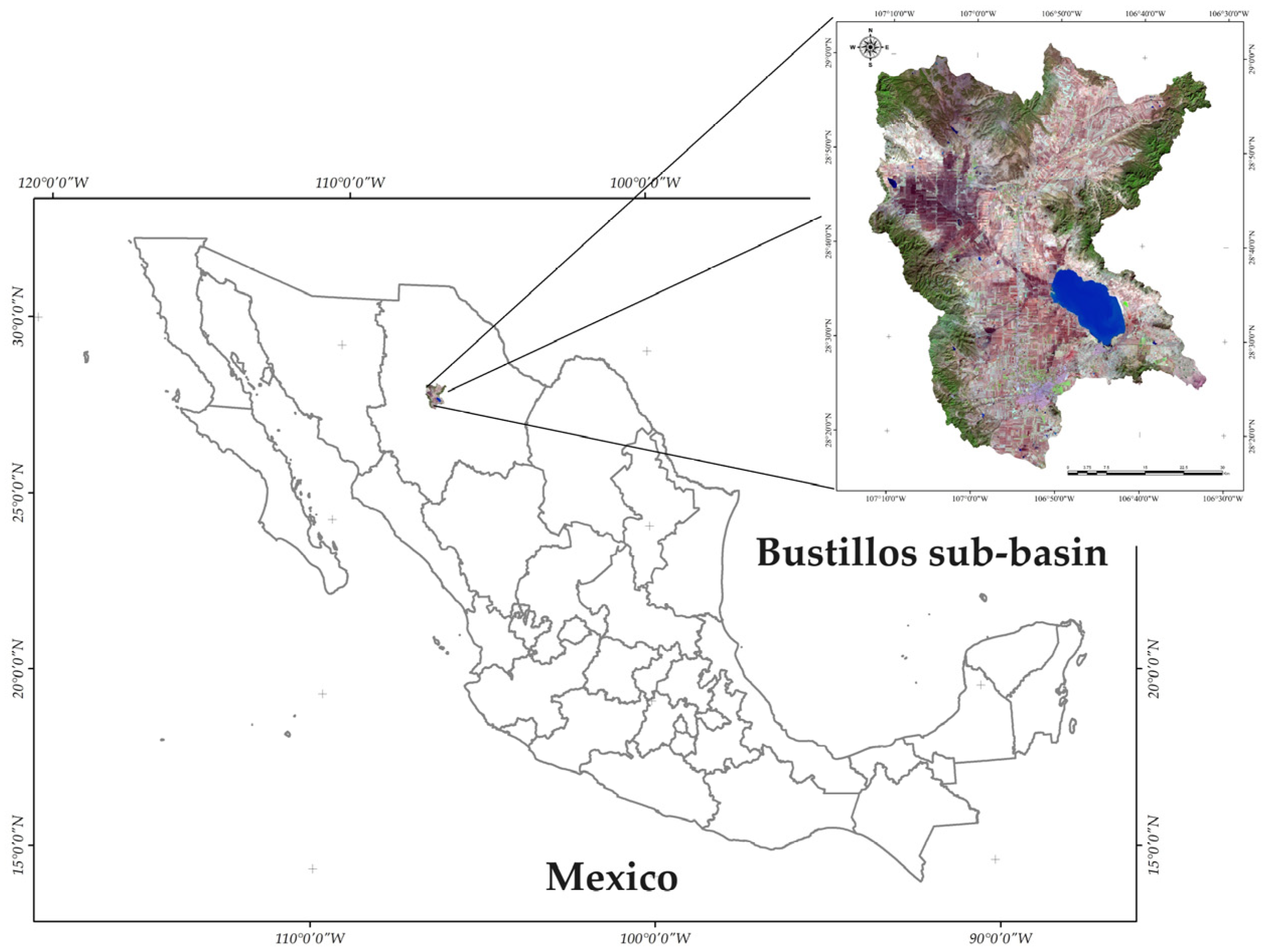
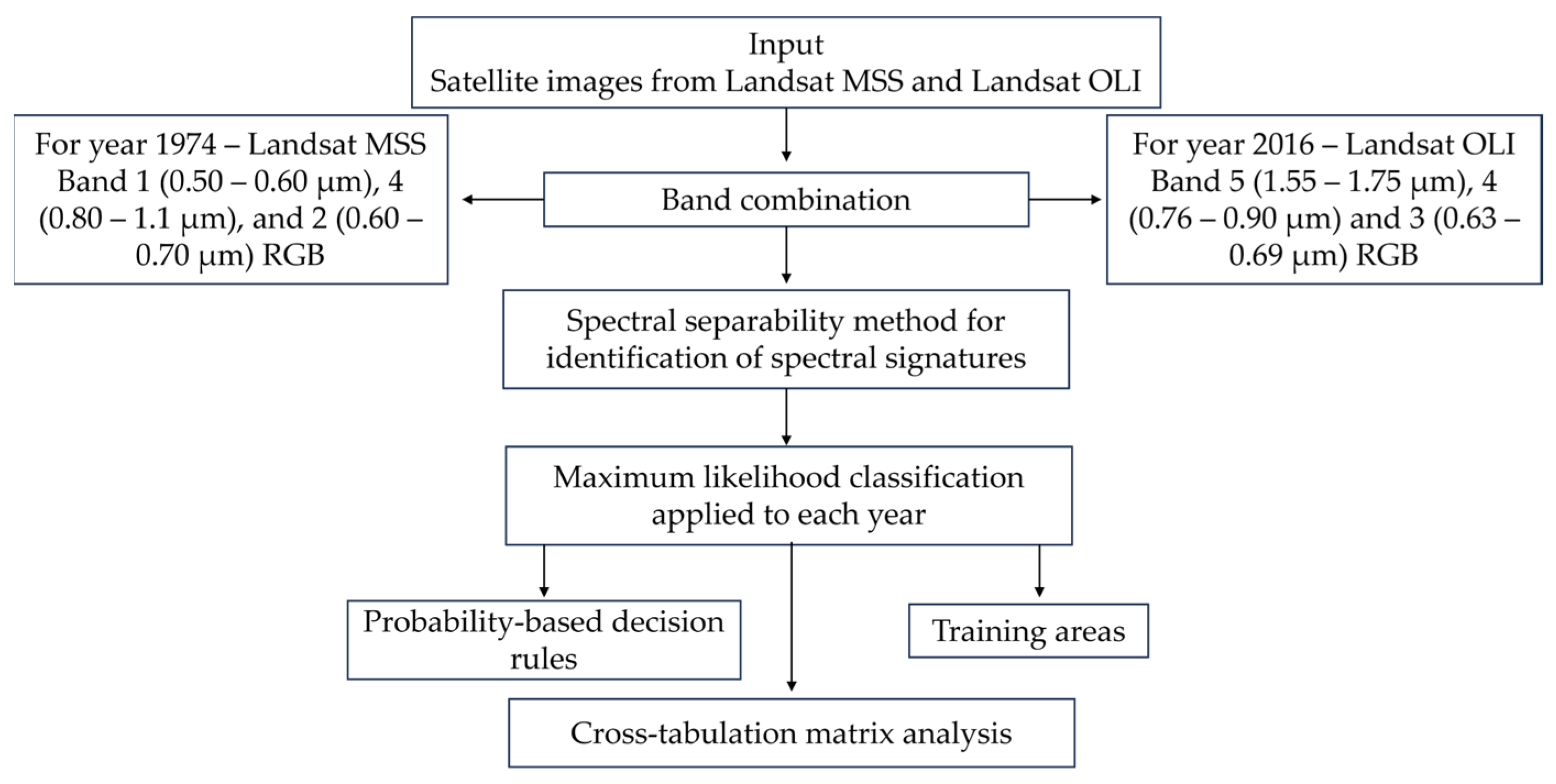
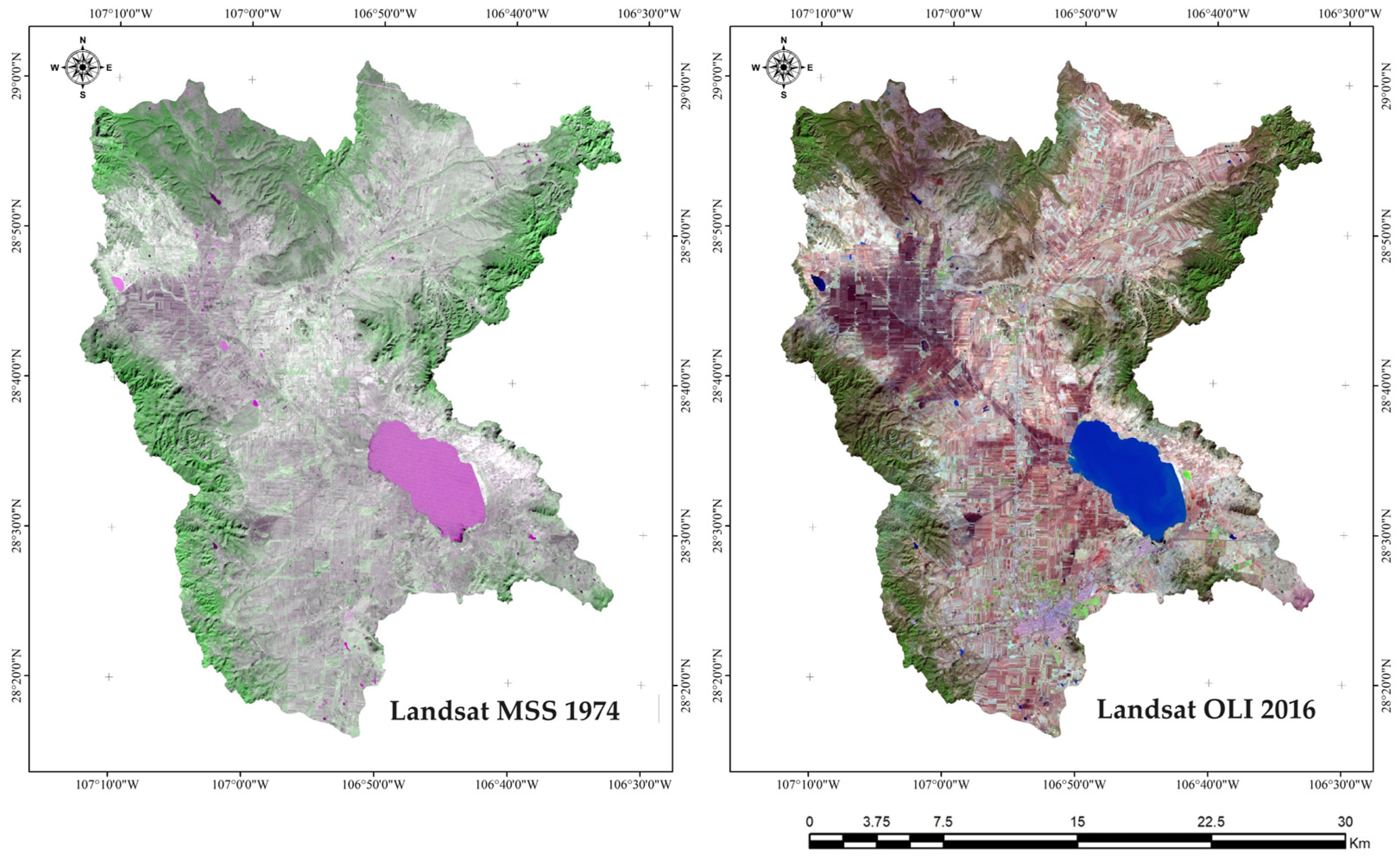
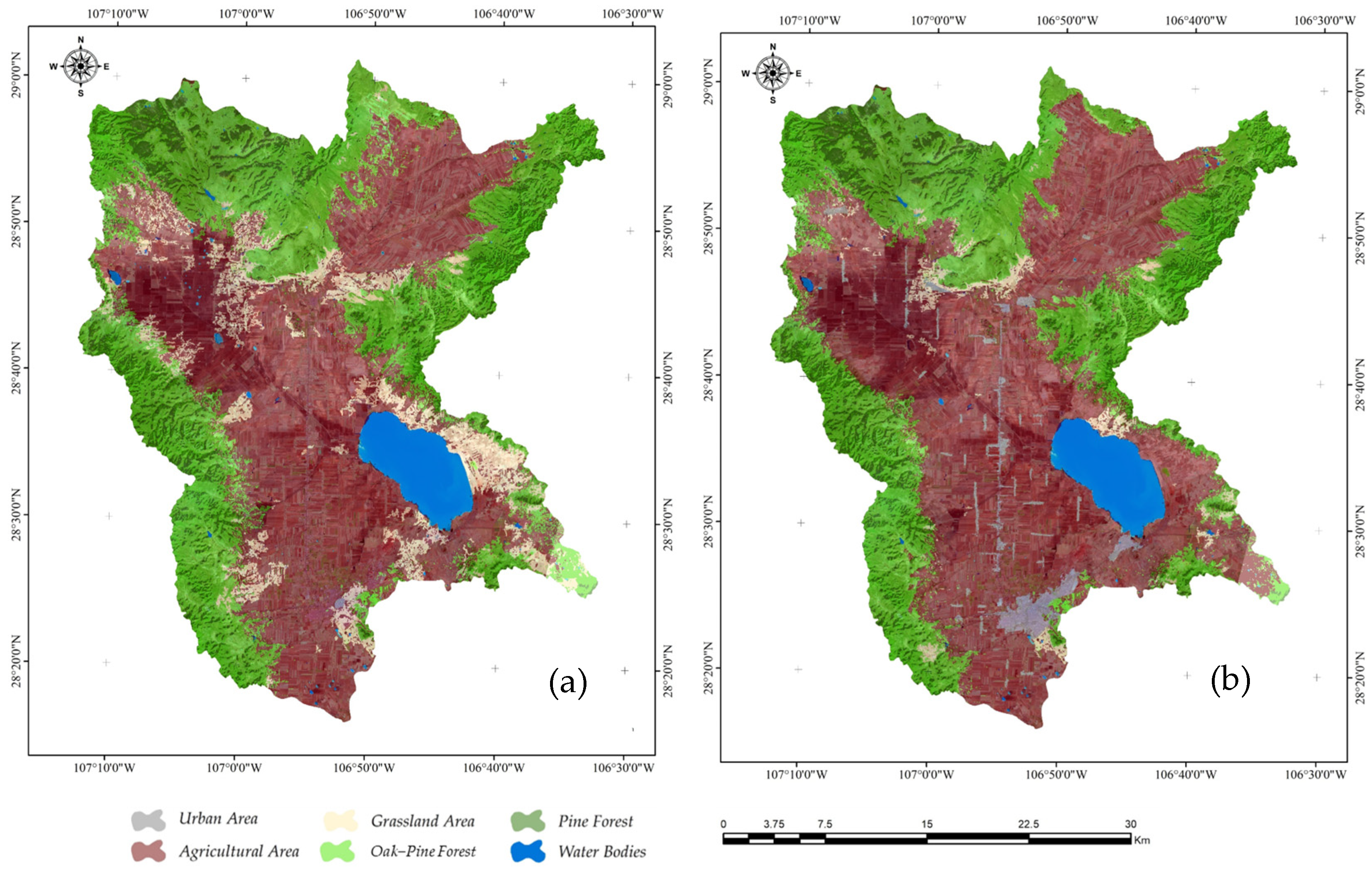
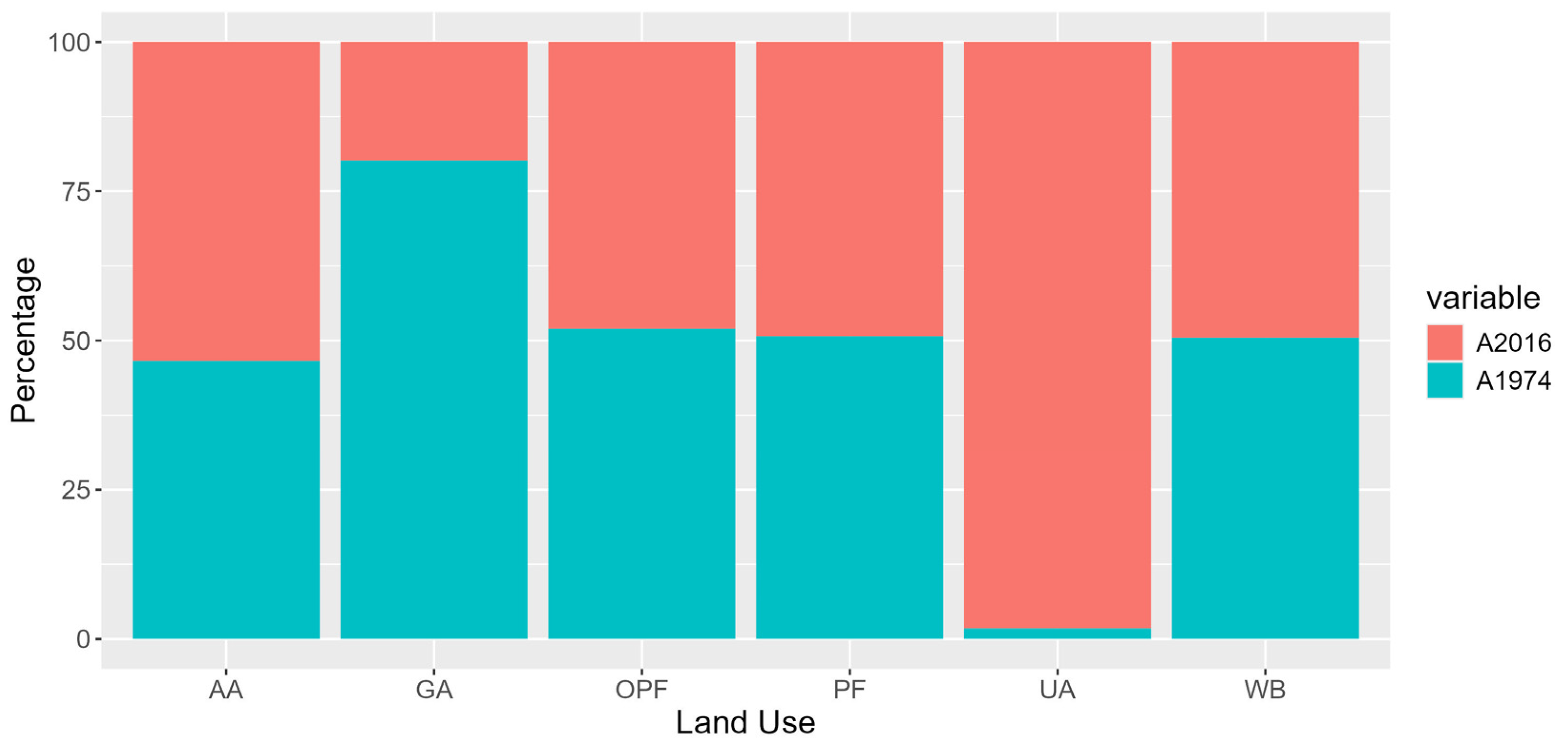
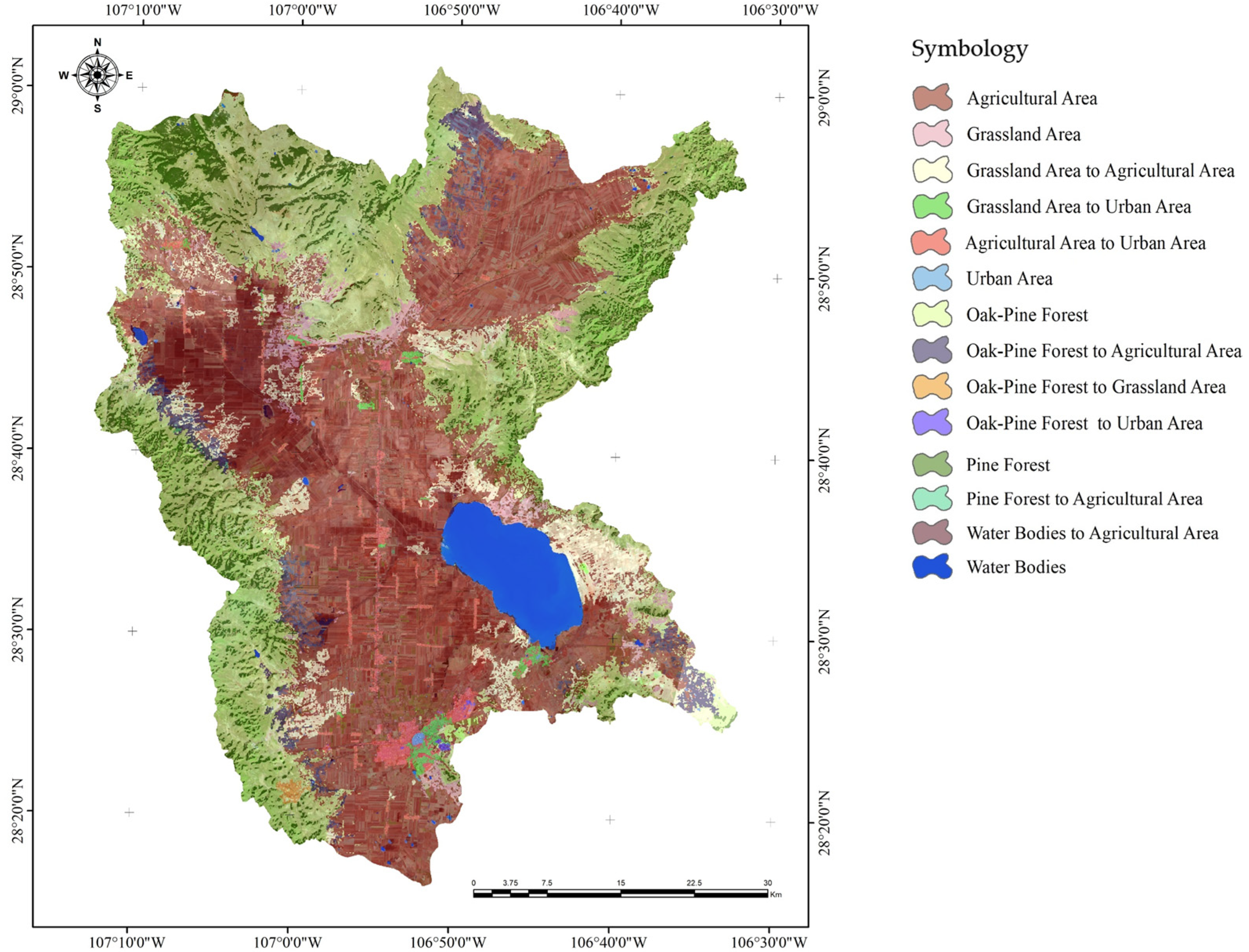
| Variable | 1970 | 1980 | 1990 | 2000 | 2003 | 2010 | 2020 |
|---|---|---|---|---|---|---|---|
| Population | 66,856.00 | 85,589.00 | 112,589.00 | 124,378.00 | NA | 154,639.00 | 180,638.00 |
| P.G.R. (%) | NA | 28.02 | 31.55 | 10.47 | NA | 24.33 | 16.81 |
| Total Land Crop | 113,366.00 | NA | 113,400.00 | 267,800.00 | NA | 272,390.00 | NA |
| Rainfed Agr. | 111,395.00 | NA | 77,432.00 | 67,767.00 | 67,005.00 | 64,156.77 | 73,517.00 |
| Irrigation Agr. | 1737.60 | NA | 33,186.00 | 40,192.00 | 45,879.45 | 46,393.91 | 49,789.30 |
| Planted area | 113,132.60 | NA | 110,618.00 | 107,959.00 | 112,844.45 | 110,550.00 | 123,306.30 |
| Data | Date | % Cloud | Data Source | Spatial Resolution |
|---|---|---|---|---|
| Landsat MSS | November 1974 | 0 | Global Visualization Viewer (GloVis) from the USGS. https://glovis.usgs.gov | 30 m × 30 m |
| Landsat OLI | October 2016 | 0 | GloVis from the USGS. https://glovis.usgs.gov | 30 m × 30 m |
| Time 2 | Total Year 1 | Loss | ||||
|---|---|---|---|---|---|---|
| Category 1 | Category 2 | Category 3 | Category 4 | |||
| Time 1 | ||||||
| Category 1 | P11 | P12 | P13 | P14 | P1+ | P1 ± P11 |
| Category 2 | P21 | P22 | P23 | P24 | P2+ | P2 ± P22 |
| Category 3 | P31 | P32 | P33 | P34 | P3+ | P3 ± P33 |
| Category 4 | P41 | P42 | P43 | P44 | P4+ | P4 ± P44 |
| Total year 2 | P + 1 | P + 2 | P + 3 | P + 4 | 1 | |
| Gain | P + 1 − P11 | P + 2 − P22 | P + 3 − P33 | P + 4 − P44 | ||
| Loss (L) | Gain (Gj) | Exchange (Exc) | Net Change (NC) | Total Change (TC) |
|---|---|---|---|---|
| L1 ± L11 | L + 1−L11 | 2 × MIN (L,Gj) | TC − Exc | L + Gj or |
| L2 ± L22 | L + 2−L22 | Exc + NC |
| Year/Land Use | Classification Accuracy | |||
|---|---|---|---|---|
| Producer’s Accuracy (%) | User’s Accuracy (%) | Overall Accuracy (%) | Cohen’s Kappa | |
| 1974 | 92 | 0.90 | ||
| Urban Area | 89 | 88 | ||
| Agricultura Areas | 93 | 92 | ||
| Grassland | 92 | 91 | ||
| Oak–Pine Forest | 91 | 91 | ||
| Pine Forest | 92 | 91 | ||
| Water Body | 95 | 94 | ||
| 2016 | 94 | 0.92 | ||
| Urban Area | 90 | 90 | ||
| Agricultura Areas | 94 | 93 | ||
| Grassland | 93 | 93 | ||
| Oak–Pine Forest | 90 | 89 | ||
| Pine Forest | 91 | 90 | ||
| Water Body | 96 | 96 | ||
| Land Use | 1974 | 2016 | Difference 2016–1974 |
|---|---|---|---|
| Urban Area | 141.86 | 7993.34 | 7851.48 |
| Agricultura Areas | 153,585.11 | 176,162.82 | 22,577.71 |
| Grassland | 27,883.86 | 6893.24 | −20,990.62 |
| Oak–Pine Forest | 112,216.05 | 103,607.49 | −8608.56 |
| Pine Forest | 20,488.44 | 19,901.74 | −586.7 |
| Water Body | 12,851.91 | 12,623.89 | −228.02 |
| Total | 327,167.23 | 327,182.52 |
| UA | AA | GA | OPF | PF | WB | TOTAL | LOSS | |
| UA | 141.86 | 0 | 0 | 0 | 0 | 0 | 141.86 | 0.00 |
| AA | 5756.41 | 147,827.34 | 0 | 0 | 0 | 0 | 153,583.75 | 5756.41 |
| GA | 1938.55 | 194,46.73 | 6498.42 | 0 | 0 | 0 | 27,883.70 | 21,385.28 |
| OPF | 156.52 | 8598.85 | 394.67 | 103,063.34 | 0 | 0 | 112,213.37 | 9150.03 |
| PF | 0 | 60.64 | 0 | 526.05 | 19,900.47 | 0 | 20,487.1624 | 586.69 |
| WB | 0 | 228.02 | 0 | 0 | 0 | 12,623.85 | 12,851.87 | 228.02 |
| TOTAL | 7993.34 | 176,161.5691 | 6893.08752 | 103,589.386 | 19,900.4732 | 12,623.853 | ||
| GAIN | 7851.48 | 28,334.23 | 394.67 | 526.05 | 0.00 | 0.00 |
| Dynamics of Changes | Type of Change | Area |
|---|---|---|
| Persistence of urban areas | Anthropic persistence | 141.86 |
| Agricultural land to urban areas | Urbanization | 5756.41 |
| Grasslands to urban areas | Urbanization | 1938.55 |
| Oak–pine Forest to urban areas | Urbanization | 156.52 |
| Persistence of agricultural areas | Permanence | 147,827.34 |
| Grasslands to agricultural lands | Deforestation | 19,446.73 |
| Oak–pine Forest to agricultural lands | Deforestation | 8598.85 |
| Pine forest to agricultural lands | Deforestation | 60.64 |
| Water bodies to agricultural lands | Others | 228.02 |
| Grasslands persistence | Natural persistence | 6498.42 |
| Oak–pine Forest to grasslands | Degradation | 394.67 |
| Oak–pine Forest persistence | Natural persistence | 103,063.34 |
| Pine forest to oak–pine forest | Degradation | 526.05 |
| Pine forest persistence | Natural persistence | 19,900.47 |
| Water bodies | Natural persistence | 12,623.85 |
| Gains | Losses | Exchanges | Net Change | Total Change | |
|---|---|---|---|---|---|
| Urban Areas | 7851.48 | 0.00 | 0.00 | 7851.48 | 7851.48 |
| Agricultural Areas | 28,334.23 | 5756.41 | 11,512.82 | 22,577.82 | 34,090.64 |
| Grasslands | 394.67 | 21,385.28 | 789.33 | 20,990.61 | 21,779.94 |
| Oak–pine Forest | 526.05 | 9150.03 | 1052.10 | 8623.98 | 9676.08 |
| Pine forest | 0.00 | 586.69 | 0.00 | 586.69 | 586.69 |
| Water bodies | 0.00 | 228.02 | 0.00 | 228.02 | 228.02 |
| Total | 37,106.42 | 37,106.42 | 13,354.24 | 60,858.60 | 74,212.85 |
Disclaimer/Publisher’s Note: The statements, opinions and data contained in all publications are solely those of the individual author(s) and contributor(s) and not of MDPI and/or the editor(s). MDPI and/or the editor(s) disclaim responsibility for any injury to people or property resulting from any ideas, methods, instructions or products referred to in the content. |
© 2024 by the authors. Licensee MDPI, Basel, Switzerland. This article is an open access article distributed under the terms and conditions of the Creative Commons Attribution (CC BY) license (https://creativecommons.org/licenses/by/4.0/).
Share and Cite
Valencia-Gaspar, S.; Mejía-Leyva, F.; Valles-Aragón, M.C.; Martinez-Salvador, M.; Hernández-Quiroz, N.S.; Nevarez-Rodríguez, M.C.; López-Serrano, P.M.; Vázquez-Quintero, G. Assessing the Dynamics of Land Use/Land Cover Changes between 1974 and 2016: A Study Case of the Bustillos Basin Using Remote Sensing. Land 2024, 13, 1320. https://doi.org/10.3390/land13081320
Valencia-Gaspar S, Mejía-Leyva F, Valles-Aragón MC, Martinez-Salvador M, Hernández-Quiroz NS, Nevarez-Rodríguez MC, López-Serrano PM, Vázquez-Quintero G. Assessing the Dynamics of Land Use/Land Cover Changes between 1974 and 2016: A Study Case of the Bustillos Basin Using Remote Sensing. Land. 2024; 13(8):1320. https://doi.org/10.3390/land13081320
Chicago/Turabian StyleValencia-Gaspar, Saúl, Fernanda Mejía-Leyva, María C. Valles-Aragón, Martin Martinez-Salvador, Nathalie S. Hernández-Quiroz, Myrna C. Nevarez-Rodríguez, Pablito M. López-Serrano, and Griselda Vázquez-Quintero. 2024. "Assessing the Dynamics of Land Use/Land Cover Changes between 1974 and 2016: A Study Case of the Bustillos Basin Using Remote Sensing" Land 13, no. 8: 1320. https://doi.org/10.3390/land13081320
APA StyleValencia-Gaspar, S., Mejía-Leyva, F., Valles-Aragón, M. C., Martinez-Salvador, M., Hernández-Quiroz, N. S., Nevarez-Rodríguez, M. C., López-Serrano, P. M., & Vázquez-Quintero, G. (2024). Assessing the Dynamics of Land Use/Land Cover Changes between 1974 and 2016: A Study Case of the Bustillos Basin Using Remote Sensing. Land, 13(8), 1320. https://doi.org/10.3390/land13081320








